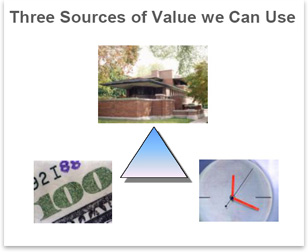
| Communicating the Value of Architecture
How do you . . . communicate the value of architecture? Summary: “Designers often struggle to quantify the value of their contribution to a project,” noted Tom Larsen, AIA, managing director of Larsen Associates LLC, Milford, Conn., during a May 5 presentation at the AIA 2007 National Convention in San Antonio. During his 90-minute seminar, Larsen offered simple techniques for architects to demonstrate their value to clients while meeting design objects. He also took time to focus on the role sustainable design plays in promoting an architect’s value. “Let’s try to understand what our clients value in the services we provide,” Larson says. The answer does not have to come at the expense of design objectives, but it does have quantifiable measures, Larsen said. He suggested architects should listen to clients to get at the heart of what they prize most in the design relationship. Then the architect should internalize those values and feed it back to them. “Talk their language,” Larsen advised, and “continue to revisit the market as it evolves.”
Time: Clients are considering how much it costs them each day the building is not completed. “Time is money, and we as architects don’t make that connection often enough,” Larsen said. He pointed out as examples casinos that stand to lose $1 million per day when not operational or a pharmaceutical company that fast-tracked its laboratory facility so it could get its scientists in the door as quickly as possible to begin drug development. For the project, the architect moved its offices to the site to facilitate delivery. Cost: Larsen suggested focusing on what the owner can expect by employing your firm. For example, he suggested using low change-order rates as a marketing tool. He noted that when change-order rates are well below the standard of care expected for the project type, that figure becomes a good indication of past history. He shared the story of one management consulting client who did a rough test of making it a point to mention his firm’s excellent history of minimal change orders. Larsen reports that his client found he had a 50 percent hit rate for commissions when he mentioned his firm’s record, versus a 30 percent hit rate when he did not. Focus on what the owner can expect by employing your firm Quality The pitch and delivery Rather than chase clients that you don’t know, court relationships with clients you do know Larsen also advises to appeal to what clients will lose, not necessarily to what they will gain by implementing a particular design strategy. It has to be fact-based, Larsen said. People are risk averse and will naturally respond to that. A different kind of green Green and sustainable design is an important way architects can reconnect with clients Fifteen years ago, sustainable design was a far-out concept among client groups; 10 years ago it was much more accepted. And now, Larsen says, there is just a smattering of people who do not think it is a good idea. The trick today for getting clients actually to implement these principles, Larsen says, is bringing it back to monetary value. “Dollars and cents make a lot of sense,” Larsen says. Just by installing a kilowatt meter that converts energy consumption to dollars, users reap an 8-10 percent savings.” It’s a matter of transferring that concept to whole building design, he noted. “There is always a LEED® value-engineering exercise that takes place.” Larsen asked the architects to consider their own agenda. We’re all making compromises in our decisions.” That is especially important in determining values and priorities, he concluded. |
||
Copyright 2007 The American Institute of Architects. All rights reserved. Home Page |
||
news headlines
practice
business
design

 Three sources of value
Three sources of value